Santorini’s best-kept secret is Ancient Akrotiri, a buried city that is one of the most important archaeological sites in Greece. Here’s the where, why, and how to walk through the excavated streets and peer into the homes of the people who perished when a volcanic explosion tore apart the island of Thera, ending the Minoan period.
Akrotiri Santorini is the location of one of the most significant archaeological sites in the Aegean and in Greece. Visiting Akrotiri Village is like visiting a mini-Pompeii, an ancient settlement of an advanced and prosperous Bronze Age people suddenly buried in volcanic ash.
Here’s the story of what’s been called the ‘Lost Atlantis’ site of Akrotiri and the best ways to buy tickets and visit the site.
Don’t miss your chance to see the ancient ruins of this Minoan city on the tip of Santorini island on your next trip to Santorini.
Akrotiri Archaeological Site Entrance Tickets
You can stand in line with the tour groups, cruise ship day trippers, and everyone who has just got off the public bus, or you can pre-purchase a skip-the-line ticket with free cancellation up to 24 hours before your booking date and time.
The best 1 hour private guided tour of the archaeological site is the Santorini: Akrotiri Prehistoric City Private Guided Tour which sells out quickly.
Admission fees at the site:
- General Admission € 12.
- €6 for EU citizens aged 65 or over and students of universities or other higher education institutions from outside the EU.
- Entry is free for visitors under the age of 18 and students from institutions inside the EU.

Opening Times (and Days)
The prehistoric city archaeological site operates on a timetable divided into winter and summer. These are the site’s opening days and times:
- In winter (from November 1 to March 31), the site is open from 8 am to 3 pm.
- In summer (from April 4 to October 31), the site is open from 8 am to 8 pm daily, and from 8 am to 3 pm on Thursdays.
- The site is closed on Mondays throughout the year.
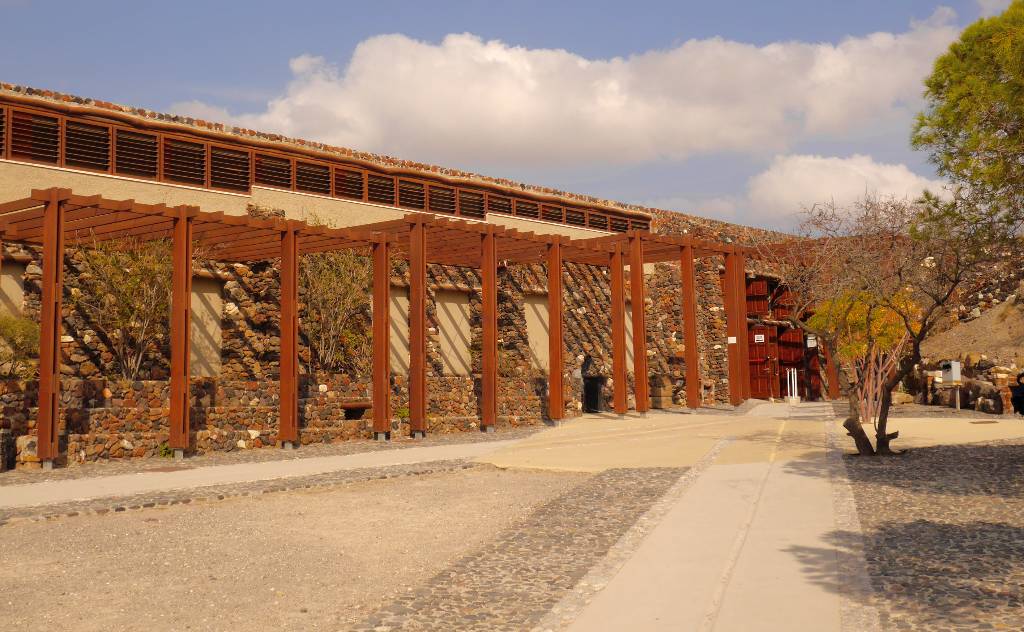
When to Visit Akrotiri
- Cruise ship day trippers come in large numbers to the site from about 10 am. It is a small site and it can become difficult to read the displays.
- Try to be there as the site opens for the day or just before closing time to beat the crowds.
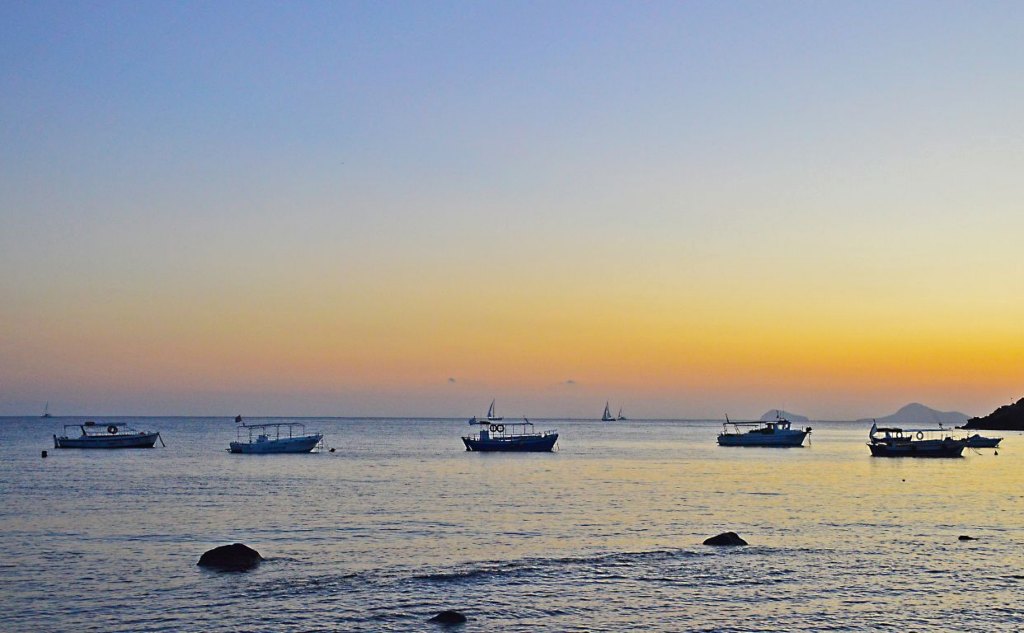
Map of Santorini and Ancient Akrotiri
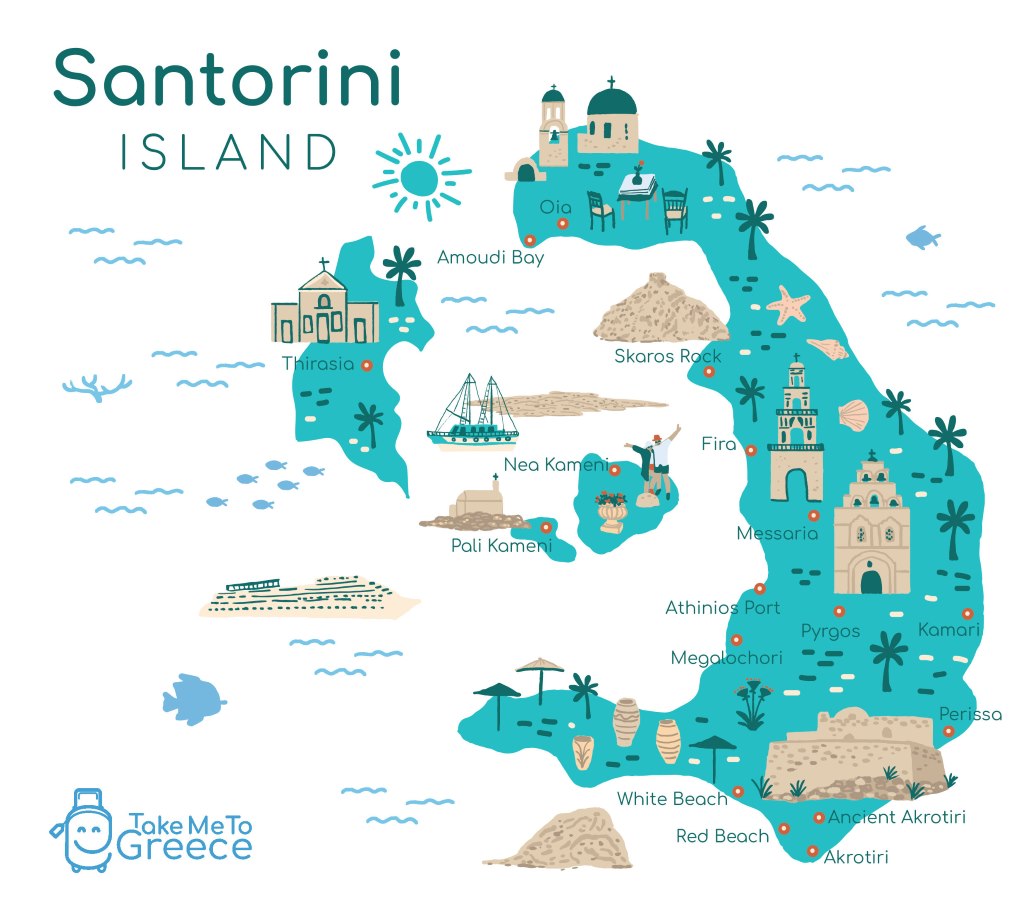
Practical Info and Tips on Visiting Ancient Akrotiri
There are few amenities besides toilets and a gift shop at the site, but a one-minute walk brings you to the tiny port of the village of Akrotiri, and another five minutes along the coastline is the Red Beach, a stop on all sailing and bus tours of the island.
🚏 The bus from Oia (Ia) and Fira (Thera) winds through vineyards to the southwest tip of the island, before pulling up beside a tree across from the entrance gate to the Akrotiri archaeological site.
If you wander a minute further down the road towards the sea you may see the bus parked there.
Akrotiri, as opposed to the Akrotiri archaeological site, is often its first stop, meaning that you will get a seat for the journey back!
It’s not a big deal if you don’t mind the conductor squeezing past you twice on his journey to the back of the bus and back again.
🚙 By rental car – if you’ve hired a car to get around Santorini (it’s cheaper and safer to pre-book through a reputable company online for the best rates and to be sure you will have one when you arrive), there’s a car park at the Red Beach at Akrotiri, about 250 m from the entrance to the site.
🏖️ As you enter Akrotiri, you’ll see the archaeological site to your left, the modern-day village and bus stop straight ahead, and the red cliffs of the Red Beach to your right.
- Santorini Bus Timetable here: santorini_bus_timetable
- Costs and opening hours of the Thera Museum of Prehistory here
Inside the Akrotiri Archaeological Site
Once you’ve paid admission, you enter a large covered structure that comprises all the excavated areas to date.
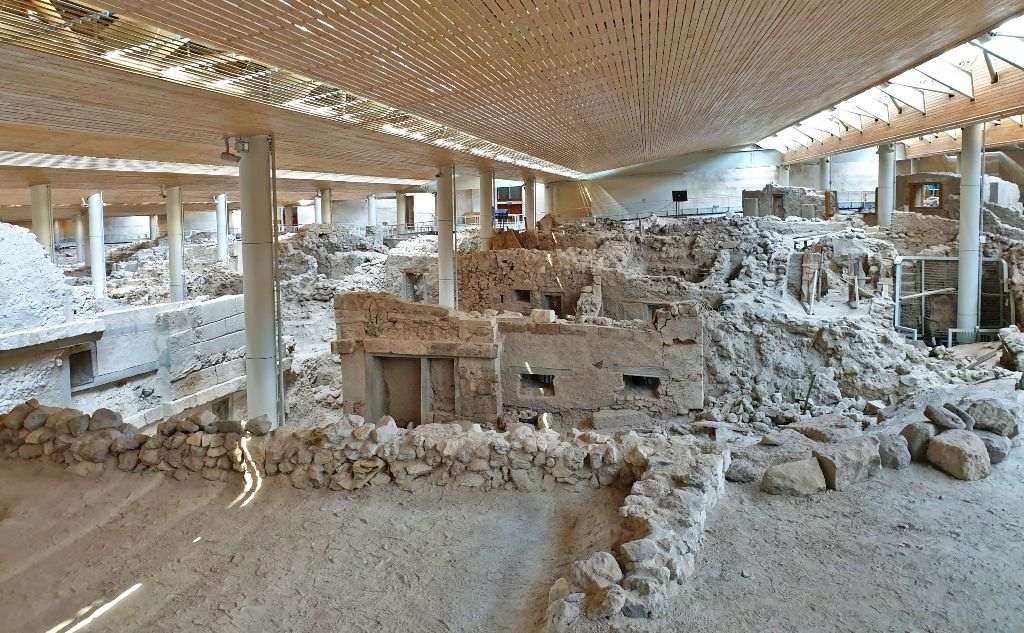
A bioclimatic roof covers the entire archaeological site and walkways suspended above the excavations allow you to wander through and above the site and a path leading through the streets of the ancient city has been cleared.
Along the paths, you can peer into windows and doorways and get a real feel for how light and airy these impressive homes and civic buildings would have been.
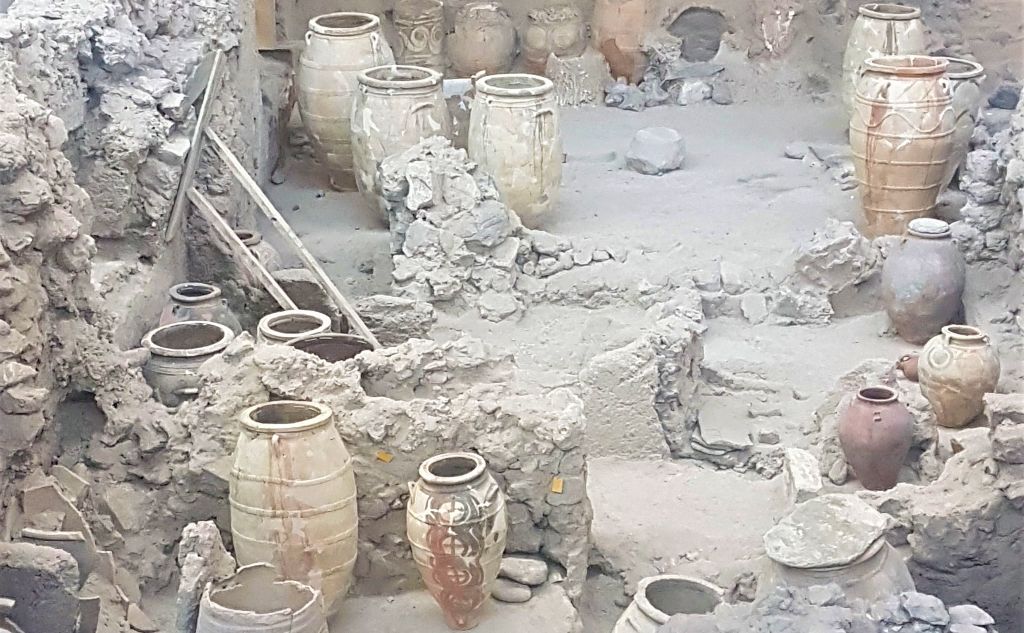
Dodgy restorations, looting and pillaging, and the ravages of time and the elements account for why so many ancient sites are poorly preserved.
The lava that destroyed this Minoan civilization also preserved it. It makes it possible to almost precisely replicate every aspect of the architecture, streetscape, furniture, wall and floor coverings, daily utensils and vessels, and religious shrines.
Walk along the streets of this Minoan village and imagine what it would be like to be a resident.
It is easy to picture yourself living in these houses, sitting on a rooftop balcony, and enjoying the breathtaking view.
(A view that is just as breathtaking today – with the addition of the extra islands that were created when Santorini exploded in the eruption!)
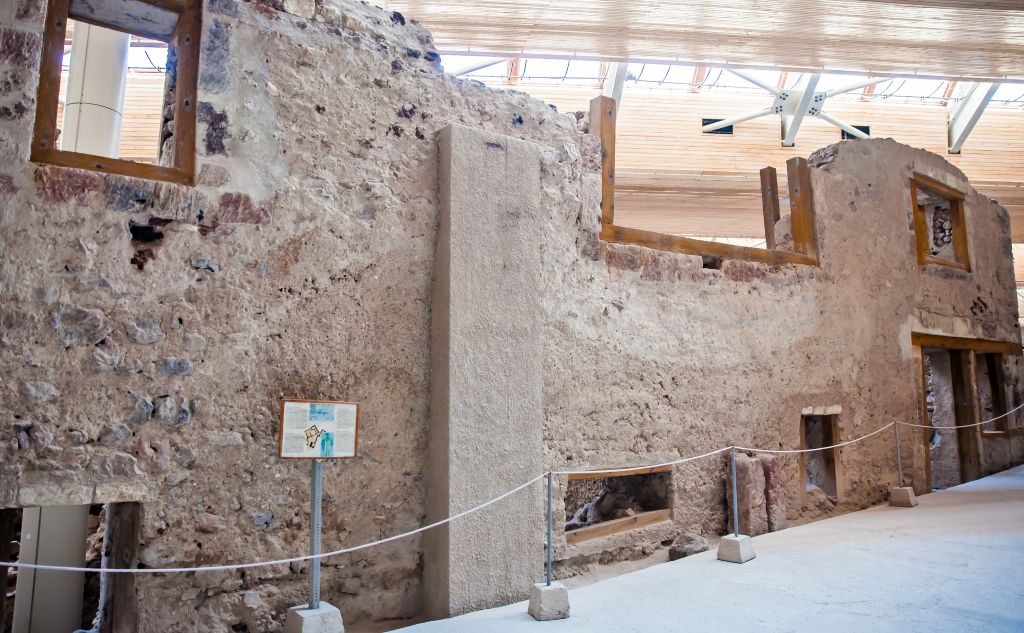
Several severe earthquakes occurred before the eruption. The eruption gave time for the residents to leave but not enough time to take household items with them.
The site is unusual because these houses had three floors or stories.
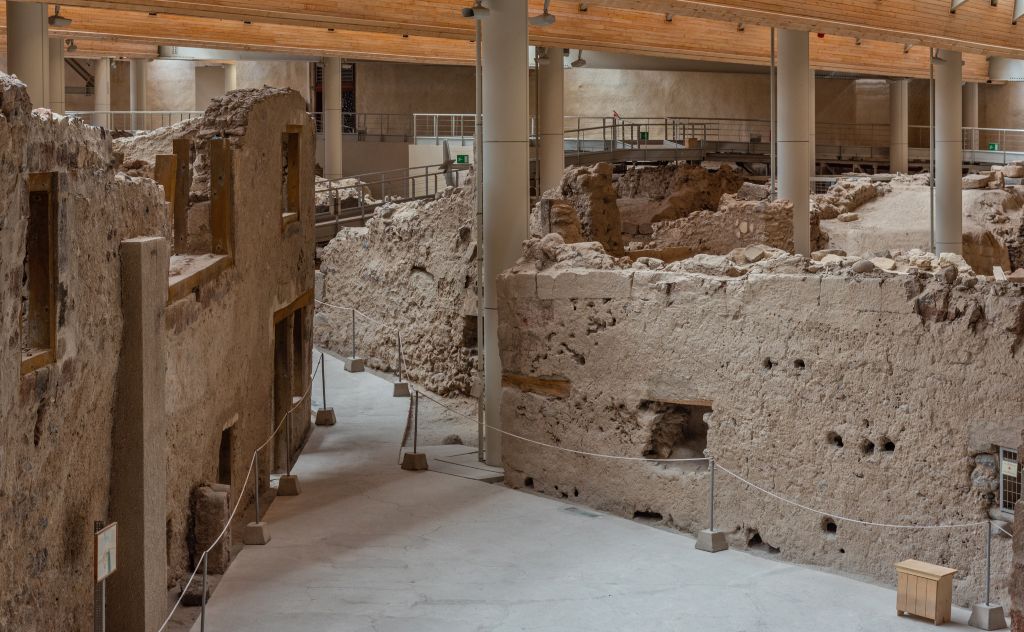
It has been possible to recreate each of them. The work has a long way to go and only a fraction of the site has been excavated. New items are continuing to be discovered.
Once you’ve walked along the raised walkways, head down to Triangle Square and look through the doors and windows of people who lived and loved here 3500 years ago. It will send tingles up your spine!
The landscape of Santorini provides numerous minerals which gave the artwork its vivid colors.
Luckily, the minerals have also preserved the designs for centuries.
Santorini lifestyles before the eruption
Not just any old Aegean fishing and farming village, the inhabitants of Akrotiri, a Minoan Bronze Age settlement of the ancient world, lived more than 3,500 years ago and were seriously wealthy.
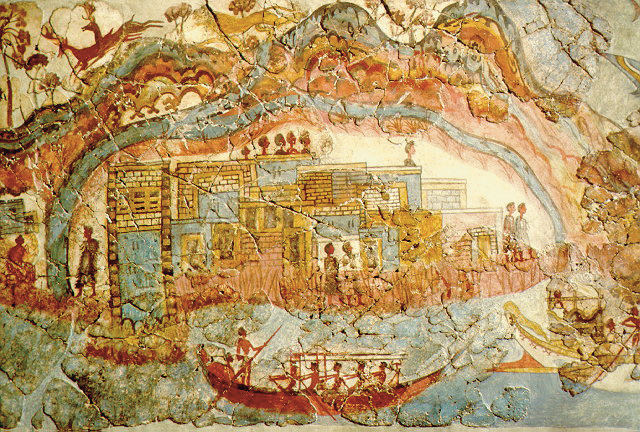
They lived in stone buildings, sometimes three stories high with masonry facings, latrines and sewerage systems, an elaborate drainage system, and large airy rooms facing the Aegean Sea.
The walls were reinforced with wooden beams from Crete to help the buildings withstand earthquakes.
Ceramics and pottery production in Akrotiri certainly occurred, but they also possessed wonderfully delicate teacups from Crete, vases from Knossos, and chlorite vessels from the Early Cycladic period (c. 2700-2400/2300 B.C.).
Other household items came from as far afield as the Dodecanese islands, the Greek mainland, Cyprus, Egypt, Palestine, and Syria.
It was all going so well…
A beginner’s guide to the biggest natural catastrophe in human history
The young men and women are depicted in frescoes and they are fashionable and appear carefree and confident.
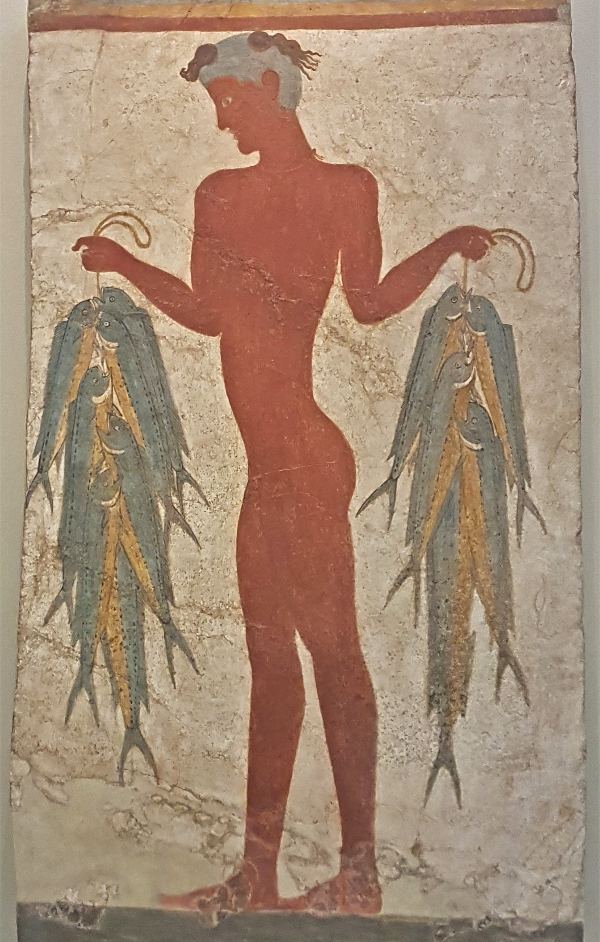
This sophisticated society lies at the southern tip of the island of Santorini (ancient Thera), beside the modern-day village of Akrotiri.
It flourished until the residents evacuated as the largest geological event in human history occurred – the Theran volcanic eruption.
The mother of all volcanic eruptions, the Theran eruption abruptly ended the great Minoan culture of the Bronze Age.
A layer of tephra (a kind of volcanic ash) from the Theran eruption has been found in a lake in Western Turkey.
Geologists agree that the eruption of the volcano is the biggest natural event that has ever been recorded by humans.
The exact date of the eruption isn’t known, but the Egyptian New Kingdom’s records may contain a reference to the event in around 1560-1546 BC.
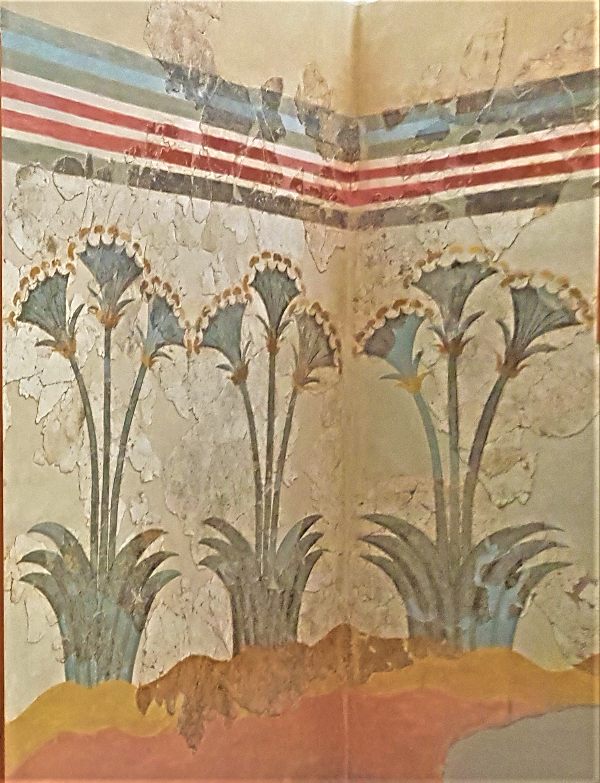
Like Pompeii, Akrotiri was covered in lava and its remains are slowly being excavated. In fact, it lay undiscovered until the ash from the volcanic eruption was being used to build the Suez Canal in 1967.
But when excavations finally began, archaeologists found the walls inside the houses were decorated with brightly colored frescoes of flowers, animals, religious rituals, and everyday life in Akrotiri.
Animals such as monkeys and deer decorate the floors and walls of the second level of the buildings. The frescoes appear in all of the homes, not just those of the wealthy.
Wildflowers (saffron and crocuses) were popular as were geometrical shapes.
Ancient Akrotirians loved the sea and underwater life. This is clear in their intricate and plentiful seascapes and marine designs.
Jewelry and hairstyles tell us so much about this sophisticated culture.
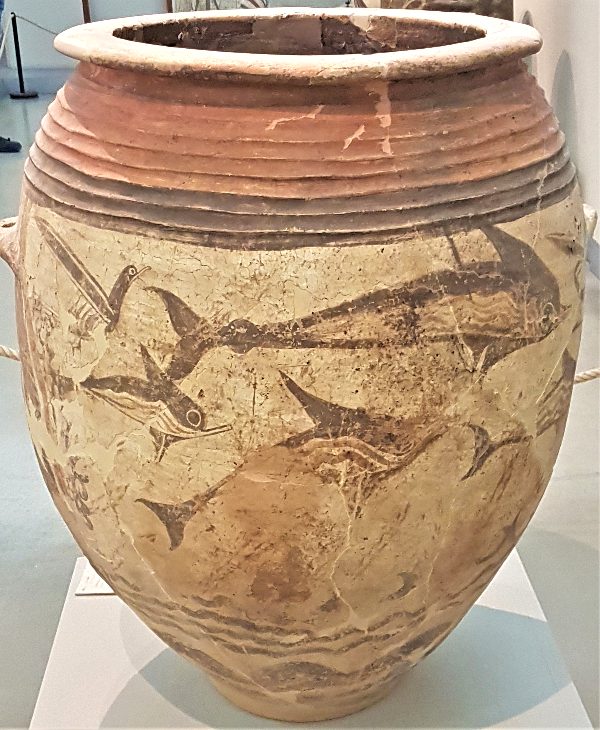
Like many cities, it is laid out with its largest buildings facing the main streets and towards Crete (the center of Minoan culture). Archaeologists have only excavated a dozen houses and civic buildings so far.
The back streets contain more domestic-sized architecture.
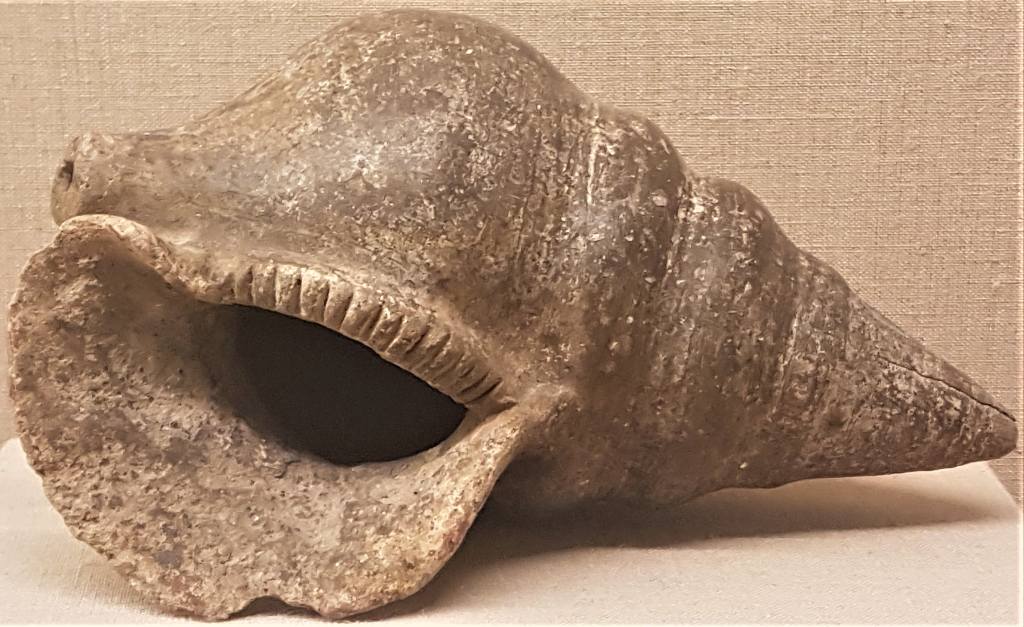
It is here that you can see wonderfully preserved vessels of all sizes. The Aegean lifestyle is clear in these painted vessels with dolphins, fish, birds, and waves decorating their sides.
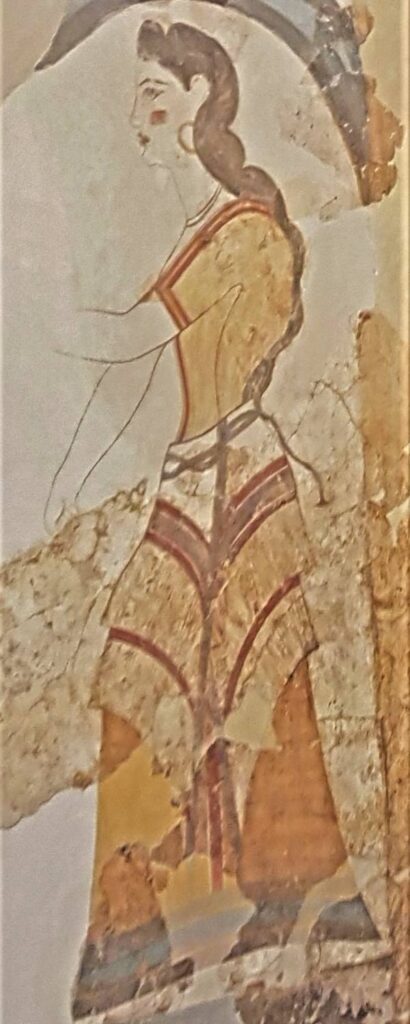
However, unlike archaeological sites such as Pompeii, no human remains or precious objects have been found at the archaeological site of Akrotiri.
Clearly, the residents had time to beat an orderly retreat.Right at the southwestern tip of the island, you can walk through the streets of Akrotiri.
This small hamlet has been a fishing village since the Late Neolithic times ( since at least the sixth century BC!)
It was the main stopover port between Cyprus and the advanced Minoan civilization of Crete. Akrotiri copper molds and crucibles hint at a major source of the village’s wealth.
It vies with many other ancient sites as the possible location of the lost city of Atlantis. Is Akrotiri Atlantis? The Ancient Akrotirian name for the village before the eruption is not known.
It is hard to conceive the scale of this disaster. The volcanic eruption blew the island of Santorini into multiple smaller islands where they lay, uninhabited, for several centuries.
Museum of Prehistoric Thera in Santorini
It is disappointing that there is no Akrotiri museum on site. Instead, you need to head back into town to the Museum of Prehistoric Thera.
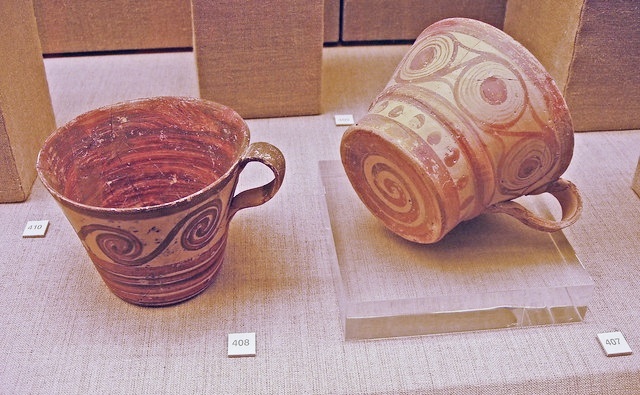
It is definitely worth the effort to visit the Museum of Prehistoric Thera after you’ve been to Akrotiri.
Like so many archaeological sites in Greece, they are interesting but empty ruins that only come to life once you’ve visited the nearby museum.
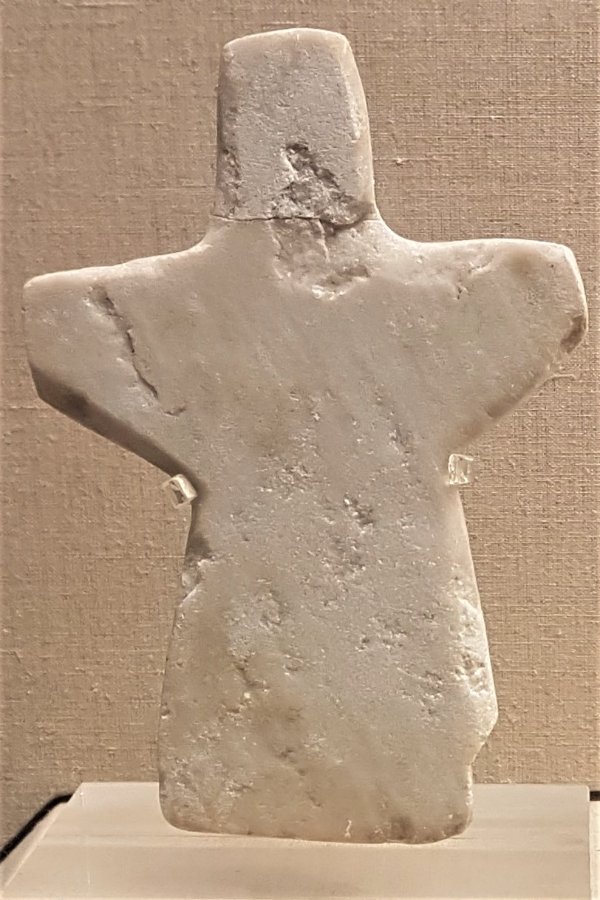
The archaeological museum has some excellent 4000-year-old Cycladic figures from Santorini.
It is here you can see the wall frescoes, vessels, pottery, and other objects unearthed at the archaeological site.
If your travels will take you to the National Archaeological Museum of Athens, you can also see the “Akrotiri of Thera” room with objects from Akrotiri.








